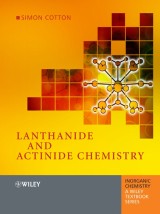Details

Lanthanide and Actinide Chemistry
Inorganic Chemistry: A Textbook Series, Band 27 1. Aufl.
|
50,99 € |
|
| Verlag: | Wiley |
| Format: | |
| Veröffentl.: | 30.01.2007 |
| ISBN/EAN: | 9780470010075 |
| Sprache: | englisch |
| Anzahl Seiten: | 288 |
DRM-geschütztes eBook, Sie benötigen z.B. Adobe Digital Editions und eine Adobe ID zum Lesen.
Beschreibungen
The only introduction into the exciting chemistry of Lanthanides and Actinides. <ul> <li>The book is based on a number of courses on "f elements"</li> <li>The author has a long experience in teaching this field of chemistry</li> <li>Lanthanides have become very common elements in research and technology applications; this book offers the basic knowledge</li> <li>The book offers insights into a vast range of applications, from lasers to synthesis</li> </ul> <p>The <i>Inorganic Chemistry: A Textbook</i> series reflects the pivotal role of modern inorganic and physical chemistry in a whole range of emerging areas, such as materials chemistry, green chemistry and bioinorganic chemistry, as well as providing a solid grounding in established areas such as solid state chemistry, coordination chemistry, main group chemistry and physical inorganic chemistry.</p> <p><i>Lanthanide and Actinide Chemistry</i> is a one-volume account of the Lanthanides (including scandium and yttrium), the Actinides and the Transactinide elements, intended as an introductory treatment for undergraduate and postgraduate students. The principal features of these elements are set out in detail, enabling clear comparison and contrast with the Transition Elements and Main Group metals.</p> <p>The book covers the extraction of the elements from their ores and their purification, as well as the synthesis of the man-made elements; the properties of the elements and principal binary compounds; detailed accounts of their coordination chemistry and organometallic chemistry, from both preparative and structural viewpoints, with a clear explanation of the factors responsible for the adoption of particular coordination numbers; spectroscopy and magnetism, especially for the lanthanides, with case studies and accounts of applications in areas like magnetic resonance imaging, lasers and luminescence; nuclear separations and problems in waste disposal for the radioactive elements, particularly in the context of plutonium.</p> <p>Latest developments are covered in areas like the synthesis of the latest man-made elements, whilst there is a whole chapter on the application of lanthanide compounds in synthetic organic chemistry.</p> <p>End-of-chapter questions suitable for tutorial discussions are provided, whilst there is a very comprehensive bibliography providing ready access to further reading on all topics.</p>
Preface. <p>1 Introduction to the Lanthanides.</p> <p>2 The Lanthanides – Principles and Energetics.</p> <p>3 The Lanthanide Elements and Simple Binary Compounds.</p> <p>4 Coordination Chemistry of the Lanthanides.</p> <p>5 Electronic and Magnetic Properties of the Lanthanides.</p> <p>6 Organometallic Chemistry of the Lanthanides.</p> <p>7 The Misfits: Scandium, Yttrium, and Promethium.</p> <p>8 The Lanthanides and Scandium in Organic Chemistry.</p> <p>9 Introduction to the Actinides.</p> <p>10 Binary Compounds of the Actinides.</p> <p>11 Coordination Chemistry of the Actinides.</p> <p>12 Electronic and Magnetic Properties of the Actinides.</p> <p>13 Organometallic Chemistry of the Actinides.</p> <p>14 Synthesis of the Transactinides and their Chemistry.</p> <p>Bibliography.</p> <p>Index.</p>
"It provides a general background, which can then be used to study any fields of interest" (<i>Physical Sciences Educational Reviews</i>, December 2006) <p>"…a well-written introduction to the often-overlooked lanthanide, actinide, and transactinide elements…highly recommended." (<i>CHOICE</i>, October 2006)</p>
<b>Dr Simon Cotton</b> obtained his PhD at Imperial College London. After postdoctoral research and teaching appointments at Queen Mary College, London, and the University of East Anglia, he has taught chemistry in several different schools, and has been at Uppingham School since 1996. From 1984 until 1997, he was Editor of Lanthanide and Actinide Compounds for the <i>Dictionary of Organometallic Compounds</i> and the <i>Dictionary of Inorganic Compounds</i>. He authored the account of Lanthanide Coordination Chemistry for the 2nd edition of <i>Comprehensive Coordination Chemistry</i> (Pergamon) as well as the accounts of Lanthanide Inorganic and Coordination Chemistry for both the 1st and 2nd editions of the <i>Encyclopedia of Inorganic Chemistry</i> (Wiley).
"This Series reflects the pivotal role of modern inorganic and physical chemistry in a whole range of emerging areas, such as materials chemistry, green chemistry and bioinorganic chemistry, as well as providing a solid grounding in established areas such as solid state chemistry, coordination chemistry, main group chemistry and physical inorganic chemistry."<br /> —<i>Lanthanide and Actinide Chemistry</i>, Simon Cotton, Uppingham School, Uppingham, Rutland, UK <p>Lanthanide and Actinide Chemistry is a one-volume account of the Lanthanides (including scandium and yttrium), the Actinides and the Transactinide elements, intended as an introductory treatment for undergraduate and postgraduate students. The principal features of these elements are set out in detail, enabling clear comparison and contrast with the Transition Elements and Main Group metals.</p> <p>The book covers the extraction of the elements from their ores and their purification, as well as the synthesis of the man-made elements; the properties of the elements and principal binary compounds; detailed accounts of their coordination chemistry and organometallic chemistry, from both preparative and structural viewpoints, with a clear explanation of the factors responsible for the adoption of particular coordination numbers; spectroscopy and magnetism, especially for the lanthanides, with case studies and accounts of applications in areas like magnetic resonance imaging, lasers and luminescence; nuclear separations and problems in waste disposal for the radioactive elements, particularly in the context of plutonium.</p> <p>Latest developments are covered in areas like the synthesis of the latest man-made elements, whilst there is a whole chapter on the application of lanthanide compounds in synthetic organic chemistry.</p> <p>End-of-chapter questions suitable for tutorial discussions are provided, whilst there is a very comprehensive bibliography providing ready access to further reading on all topics.</p>
Diese Produkte könnten Sie auch interessieren:

Mass Spectrometry of Inorganic and Organometallic Compounds

von: William Henderson, J. Scott McIndoe

59,99 €

Neurodegenerative Diseases and Metal Ions, Volume 1

von: Astrid Sigel, Helmut Sigel, Roland K. O. Sigel

228,99 €

Nickel and Its Surprising Impact in Nature, Volume 2

von: Astrid Sigel, Helmut Sigel, Roland K. O. Sigel

356,99 €













